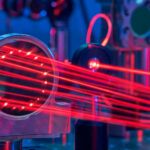February 25, 2021
The n2-Photonics team is developing technology for ultrashort pulse lasers. The German Federal Ministry for Economic Affairs and Energy is funding the start-up with 800,000 euros within the EXIST research transfer program.
„Ultra-short pulse lasers have become indispensable in research and industry. They are applied, for example, in modern microscopy processes, in the observation of fast chemical reactions, or in the material processing of ever smaller structures for medical technology and quantum computers,“ explains Christian Franke. He is responsible for both, the business part and the development of optomechanics. Kilian Fritsch and Dr. Jürgen Raab are responsible for the technical and physical development and optimization of the core technology.
To satisfy the growing demand for stable and reliable ultrafast lasers with ever shorter pulse durations and extreme bandwidths, the n2-Photonics team aims to bring the innovative pulse shortening process to market.
Present industrial-grade laser sources are limited in output pulse duration to about 200 femtoseconds by the laser media they use. This restricts peak intensity and achievable time resolution. Therefore, users rely on external pulse compressors to generate pulse durations below 10 femtoseconds. Owing to their complexity, current methods for spectral broadening and compression are only available to a small circle of experts.
Jürgen Raab explains, „Pulse shortening in itself is now a well-known technology. Our innovation is to make it easily and reliably applicable. This means for example that scientists from other disciplines can also use the technology to record super slow-motion images of fast microscopic systems. In materials processing, the increase in peak power due to pulse shortening can be used for novel manufacturing processes.“
The technology, developed during five years of research, is unique worldwide and a novelty on the market. It features unprecedented stability, reliability and life time.
The system developed by n2-Photonics makes use of solids or noble gases to broaden the frequency spectrum of laser pulses by more than ten times at peak powers ranging from several megawatts to gigawatts, thus shortening the pulse duration. At the heart of this innovative approach is a passive optical setup consisting of two opposing mirrors with a transparent medium (such as glass or sapphire) or a gas in between. This is traversed many times by the laser pulses and can thus potentially produce the necessary spectral broadening of several 100 nanometers in perspective in a cost-effective, space-saving manner with high stability and efficiency. This technology promises a large bandwidth. It converts the quasi-monochromatic light of the laser source, similar to that of a laser pointer, into multicolored white light similar to that of the sun. Because of its intrinsic simplicity, the system is expected to provide pulse durations of less than 10 femtoseconds under industrial conditions, giving industrial and research users access to this technology.
The n2-Photonics team was able to convince the jury of the EXIST research transfer funding program of the German Federal Ministry for Economic Affairs and Energy, with its innovative technology and the associated business plan. This program is aimed at outstanding, research-based start-up projects that involve complex technological development work. The funding volume during the two-year project phase amounts to over 800,000 euros. The implementation of the third-party funded project takes place at the Chair of Laser Technology and Spectroscopy.
„Thanks to the university’s excellent research infrastructure, including its own CAD department and a modern mechanical workshop, the team can significantly accelerate the prototype development. The funding application was heavily supported by Max Planck Innovation and Hamburg Innovation.“ explains Prof. Dr. Oleg Pronin, head of Laser Technology and Spectroscopy department. Oleg Pronin is one of the leading scientists in the field of ultrashort pulse lasers and supports the team in the project implementation with his scientific and technical expertise.
Letzte Änderung: 1. März 2021
